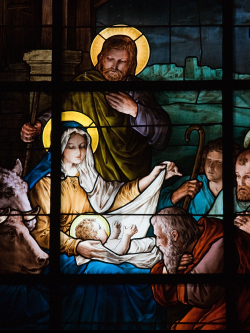 (Compiled by attorneys for The Rutherford Institute)
(Compiled by attorneys for The Rutherford Institute)
Unfortunately, Christmas has become a time of controversy over what can or cannot be done in terms of celebrating the holiday. In order to clear up much of the misunderstanding, the following twelve rules are offered:
- Public school students’ written or spoken personal expressions concerning the religious significance of Christmas (e.g., T-shirts with the slogan, “Jesus Is the Reason for the Season”) may not be censored by school officials absent evidence that the speech would cause a substantial disruption.(i)
- So long as teachers are generally permitted to wear clothing or jewelry or have personal items expressing their views about the holidays, Christian teachers may not be prohibited from similarly expressing their views by wearing Christmas-related clothing or jewelry or carrying Christmas-related personal items.[ii]
- Public schools may teach students about the Christmas holiday, including its religious significance, so long as it is taught objectively for secular purposes such as its historical or cultural importance, and not for the purpose of promoting Christianity.[iii]
- Public school teachers may send Christmas cards to the families of their students so long as they do so on their own time, outside of school hours.[iv]
- Public schools may include Christmas music, including those with religious themes, in their choral programs if the songs are included for a secular purpose such as their musical quality or cultural value or if the songs are part of an overall performance including other holiday songs relating to Chanukah, Kwanzaa, or other similar holidays.[v]
- Public schools may not require students to sing Christmas songs whose messages conflict with the students’ own religious or nonreligious beliefs.[vi]
- Public school students may not be prohibited from distributing literature to fellow students concerning the Christmas holiday or invitations to church Christmas events on the same terms that they would be allowed to distribute other literature that is not related to schoolwork.[vii]
- Private citizens or groups may display crèches or other Christmas symbols in public parks subject to the same reasonable time, place, and manner restrictions that would apply to other similar displays.[viii]
- Government entities may erect and maintain celebrations of the Christmas holiday, such as Christmas trees and Christmas light displays, and may include crèches in their displays at least so long as the purpose for including the crèche is not to promote its religious content and it is placed in context with other symbols of the Holiday season as part of an effort to celebrate the public Christmas holiday through its traditional symbols.[ix]
- Neither public nor private employers may prevent employees from decorating their offices for Christmas, playing Christmas music, or wearing clothing related to Christmas merely because of their religious content so long as these activities are not used to harass or intimidate others.[x]
- Public or private employees whose sincerely held religious beliefs require that they not work on Christmas must be reasonably accommodated by their employers unless granting the accommodation would impose an undue hardship on the employer.[xi]
- Government recognition of Christmas as a public holiday and granting government employees a paid holiday for Christmas does not violate the Establishment Clause of the First Amendment.[xii]
For more information, email The Rutherford Institute at staff@rutherford.org.
To request assistance, complete our online form or contact our Legal Department at (434) 978-3888.
Endnotes:
(i) Tinker v. Des Moines Indep. Sch. Dist., 393 U.S. 503 (1969); Nixon v. Northern Local Sch. Dist. Bd. of Educ., 383 F. Supp. 2d 965 (S.D. Ohio 2005).
[ii] See Tinker, 393 U.S. at 506 (“It can hardly be argued that either students or teachers shed their constitutional rights to freedom of speech or expression at the schoolhouse gate”). See also Tucker v. California Dep’t of Ed., 97 F.3d 1204 (9th Cir. 1996) and Nichol v. Arin Intermediate Unit 28, 268 F. Supp. 2d 536 (W.D. Pa. 2003).
[iii] See Stone v. Graham, 449 U.S. 39, 42 (1980); Grove v. Mead Sch. Dist., 753 F.2d 1528, 1534 (9th Cir. 1985).
[iv] See Pickering v. Bd. of Ed., 391 U.S. 563 (1968); Wigg v. Sioux Falls Sch. Dist. 49-5, 382 F.3d 807, 814 (8th Cir. 2004).
[v] Bauchman v. West High School, 132 F.3d 542, 554 (10th Cir. 1997); Florey v. Sioux Falls School Dist., 619 F.2d 1311 (8th Cir. 1980); Sechler v. State College Area Sch. Dist., 121 F.Supp. 2d. 439 (M.D. Penn. 2000).
[vii] Hedges v. Wauconda Comm. Unit Sch. Dist. No. 118, 9 F.3d 1295, 1297-98 (7th Cir. 1993). See “Secretary of Education’s Statement on Religious Expression,” http://www.ed.gov/Speeches/08-1995/religion.html, site visited Oct. 21, 2005.
[viii] See Capital Square Review and Advisory Board v. Pinette, 515 U.S. 753 (1995); Kreisner v. City of San Diego, 1 F.3d 775 (9th Cir. 1993);McCreary v. Stone, 739 F.2d 716 (2d Cir. 1984); Snowden v. Town of Bay Harbor Islands, 358 F. Supp. 2d 1178 (S.D. Fla. 2004).
[ix] See County of Allegheny v. American Civil Liberties Union, Greater Pittsburgh Chapter, 492 U.S. 573 (1989); Lynch v. Donnelly, 465 U.S. 668 (1984); ACLU v. Schundler, 168 F.3d 92 (3rd Cir. 1999); Amancio v. Town of Somerset, 28 F.Supp. 2d 677 (D.C. Mass. 1998).

